Strategies for Establishing Pay Plans: UCP HRM Project, F-18
VerifiedAdded on 2022/01/25
|13
|4517
|262
Project
AI Summary
This project from the University of Central Punjab, prepared by a group of BBA students, delves into the core concepts of Human Resource Management (HRM) with a specific focus on establishing effective pay plan strategies. The project begins by defining key HRM terms, including HRM itself, pay, and planning, and then proceeds to examine the fundamental factors that influence the determination of pay rates, such as the ability to pay, demand and supply dynamics in the labor market, prevailing market rates, the cost of living, the bargaining power of trade unions, productivity levels, government regulations, and the cost of training. The project also explores the concept of equity and its impact on pay rates, differentiating between external, internal, individual, and procedural equity. Furthermore, it provides a detailed overview of job evaluation, including the preparation phase, the importance of committee involvement, and various job evaluation methods, such as ranking, job grading, factor comparison, and point-ranking methods. Finally, the project addresses the concept of competitive pay, its significance in attracting and retaining employees, and the factors that affect it, including base salary, benefits, and flexible work arrangements.

University of Central Punjab
Human Resource Management
Project Topic
Establishing strategies pay plan
Submitted to:
Prof. Maria
Submitted by:
Syed Sultan Haider (S2F18BBAM0007)
Ahmad Hussain Khalid (S2F18BBAM0006)
Rana Ahmad Fraz (S3F18BBAM017)
Aroz amir (S2FI8BBAM010)
Program:
BBA-7
Session:
F-18
Human Resource Management
Project Topic
Establishing strategies pay plan
Submitted to:
Prof. Maria
Submitted by:
Syed Sultan Haider (S2F18BBAM0007)
Ahmad Hussain Khalid (S2F18BBAM0006)
Rana Ahmad Fraz (S3F18BBAM017)
Aroz amir (S2FI8BBAM010)
Program:
BBA-7
Session:
F-18
Paraphrase This Document
Need a fresh take? Get an instant paraphrase of this document with our AI Paraphraser
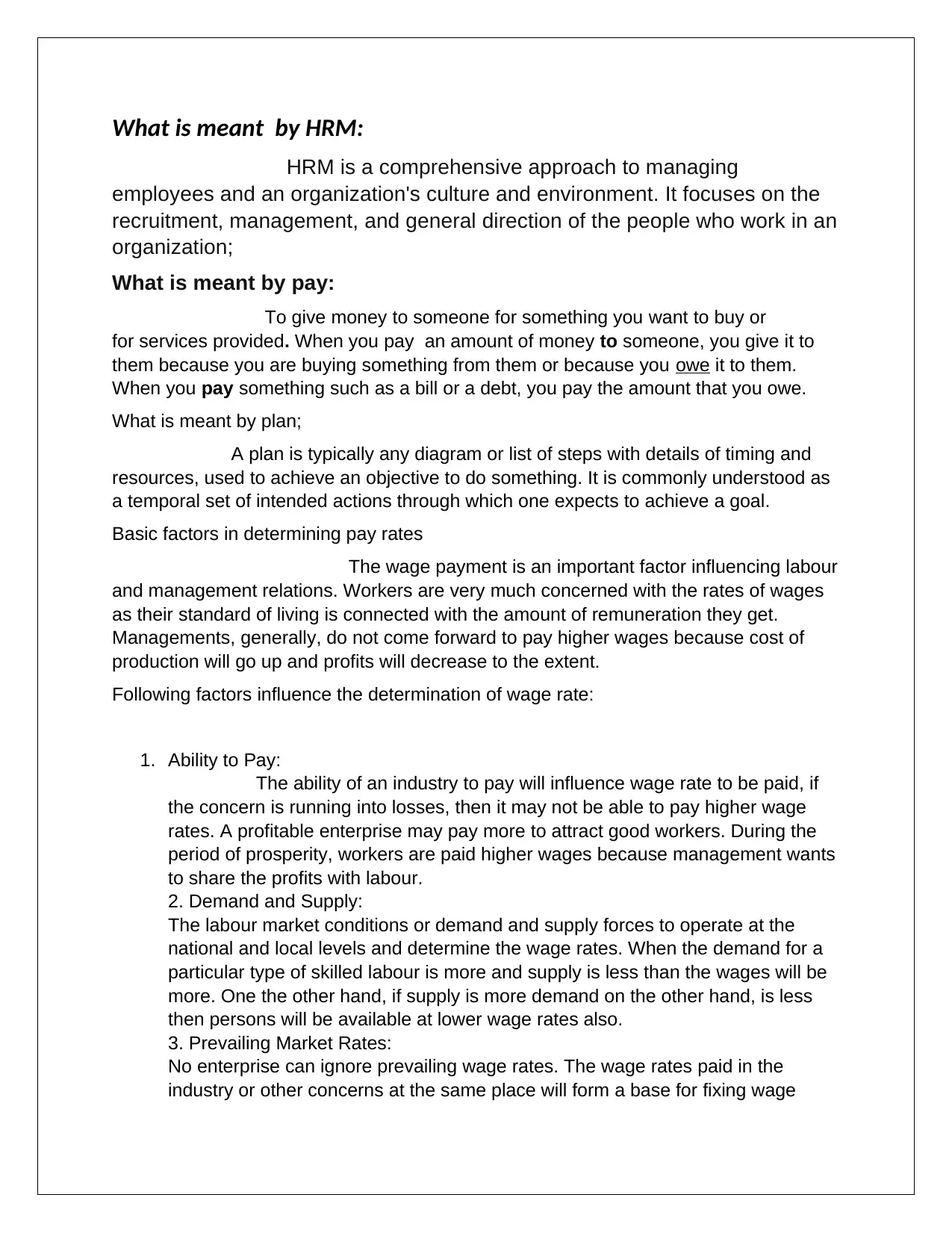
What is meant by HRM:
HRM is a comprehensive approach to managing
employees and an organization's culture and environment. It focuses on the
recruitment, management, and general direction of the people who work in an
organization;
What is meant by pay:
To give money to someone for something you want to buy or
for services provided. When you pay an amount of money to someone, you give it to
them because you are buying something from them or because you owe it to them.
When you pay something such as a bill or a debt, you pay the amount that you owe.
What is meant by plan;
A plan is typically any diagram or list of steps with details of timing and
resources, used to achieve an objective to do something. It is commonly understood as
a temporal set of intended actions through which one expects to achieve a goal.
Basic factors in determining pay rates
The wage payment is an important factor influencing labour
and management relations. Workers are very much concerned with the rates of wages
as their standard of living is connected with the amount of remuneration they get.
Managements, generally, do not come forward to pay higher wages because cost of
production will go up and profits will decrease to the extent.
Following factors influence the determination of wage rate:
1. Ability to Pay:
The ability of an industry to pay will influence wage rate to be paid, if
the concern is running into losses, then it may not be able to pay higher wage
rates. A profitable enterprise may pay more to attract good workers. During the
period of prosperity, workers are paid higher wages because management wants
to share the profits with labour.
2. Demand and Supply:
The labour market conditions or demand and supply forces to operate at the
national and local levels and determine the wage rates. When the demand for a
particular type of skilled labour is more and supply is less than the wages will be
more. One the other hand, if supply is more demand on the other hand, is less
then persons will be available at lower wage rates also.
3. Prevailing Market Rates:
No enterprise can ignore prevailing wage rates. The wage rates paid in the
industry or other concerns at the same place will form a base for fixing wage
HRM is a comprehensive approach to managing
employees and an organization's culture and environment. It focuses on the
recruitment, management, and general direction of the people who work in an
organization;
What is meant by pay:
To give money to someone for something you want to buy or
for services provided. When you pay an amount of money to someone, you give it to
them because you are buying something from them or because you owe it to them.
When you pay something such as a bill or a debt, you pay the amount that you owe.
What is meant by plan;
A plan is typically any diagram or list of steps with details of timing and
resources, used to achieve an objective to do something. It is commonly understood as
a temporal set of intended actions through which one expects to achieve a goal.
Basic factors in determining pay rates
The wage payment is an important factor influencing labour
and management relations. Workers are very much concerned with the rates of wages
as their standard of living is connected with the amount of remuneration they get.
Managements, generally, do not come forward to pay higher wages because cost of
production will go up and profits will decrease to the extent.
Following factors influence the determination of wage rate:
1. Ability to Pay:
The ability of an industry to pay will influence wage rate to be paid, if
the concern is running into losses, then it may not be able to pay higher wage
rates. A profitable enterprise may pay more to attract good workers. During the
period of prosperity, workers are paid higher wages because management wants
to share the profits with labour.
2. Demand and Supply:
The labour market conditions or demand and supply forces to operate at the
national and local levels and determine the wage rates. When the demand for a
particular type of skilled labour is more and supply is less than the wages will be
more. One the other hand, if supply is more demand on the other hand, is less
then persons will be available at lower wage rates also.
3. Prevailing Market Rates:
No enterprise can ignore prevailing wage rates. The wage rates paid in the
industry or other concerns at the same place will form a base for fixing wage
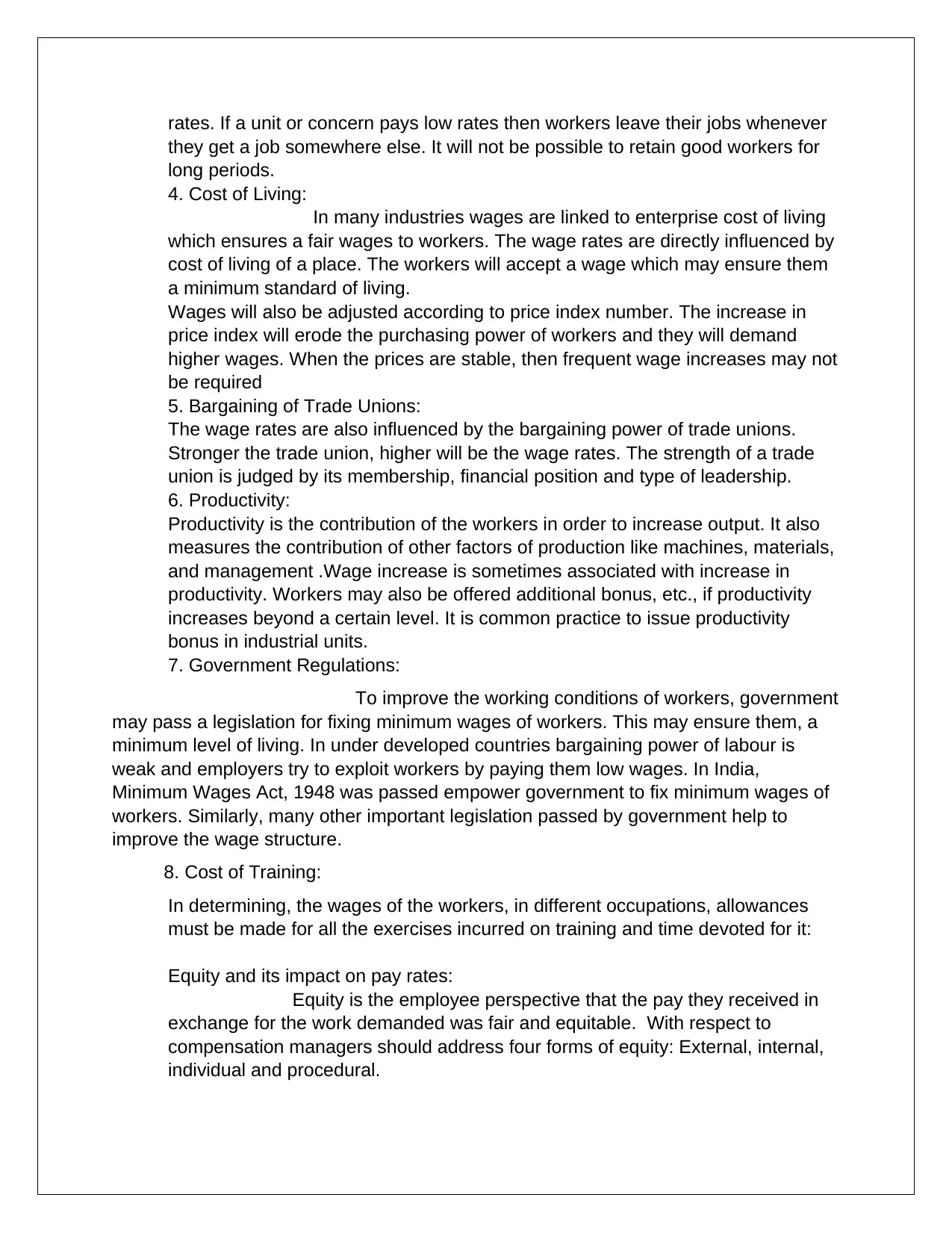
rates. If a unit or concern pays low rates then workers leave their jobs whenever
they get a job somewhere else. It will not be possible to retain good workers for
long periods.
4. Cost of Living:
In many industries wages are linked to enterprise cost of living
which ensures a fair wages to workers. The wage rates are directly influenced by
cost of living of a place. The workers will accept a wage which may ensure them
a minimum standard of living.
Wages will also be adjusted according to price index number. The increase in
price index will erode the purchasing power of workers and they will demand
higher wages. When the prices are stable, then frequent wage increases may not
be required
5. Bargaining of Trade Unions:
The wage rates are also influenced by the bargaining power of trade unions.
Stronger the trade union, higher will be the wage rates. The strength of a trade
union is judged by its membership, financial position and type of leadership.
6. Productivity:
Productivity is the contribution of the workers in order to increase output. It also
measures the contribution of other factors of production like machines, materials,
and management .Wage increase is sometimes associated with increase in
productivity. Workers may also be offered additional bonus, etc., if productivity
increases beyond a certain level. It is common practice to issue productivity
bonus in industrial units.
7. Government Regulations:
To improve the working conditions of workers, government
may pass a legislation for fixing minimum wages of workers. This may ensure them, a
minimum level of living. In under developed countries bargaining power of labour is
weak and employers try to exploit workers by paying them low wages. In India,
Minimum Wages Act, 1948 was passed empower government to fix minimum wages of
workers. Similarly, many other important legislation passed by government help to
improve the wage structure.
8. Cost of Training:
In determining, the wages of the workers, in different occupations, allowances
must be made for all the exercises incurred on training and time devoted for it:
Equity and its impact on pay rates:
Equity is the employee perspective that the pay they received in
exchange for the work demanded was fair and equitable. With respect to
compensation managers should address four forms of equity: External, internal,
individual and procedural.
they get a job somewhere else. It will not be possible to retain good workers for
long periods.
4. Cost of Living:
In many industries wages are linked to enterprise cost of living
which ensures a fair wages to workers. The wage rates are directly influenced by
cost of living of a place. The workers will accept a wage which may ensure them
a minimum standard of living.
Wages will also be adjusted according to price index number. The increase in
price index will erode the purchasing power of workers and they will demand
higher wages. When the prices are stable, then frequent wage increases may not
be required
5. Bargaining of Trade Unions:
The wage rates are also influenced by the bargaining power of trade unions.
Stronger the trade union, higher will be the wage rates. The strength of a trade
union is judged by its membership, financial position and type of leadership.
6. Productivity:
Productivity is the contribution of the workers in order to increase output. It also
measures the contribution of other factors of production like machines, materials,
and management .Wage increase is sometimes associated with increase in
productivity. Workers may also be offered additional bonus, etc., if productivity
increases beyond a certain level. It is common practice to issue productivity
bonus in industrial units.
7. Government Regulations:
To improve the working conditions of workers, government
may pass a legislation for fixing minimum wages of workers. This may ensure them, a
minimum level of living. In under developed countries bargaining power of labour is
weak and employers try to exploit workers by paying them low wages. In India,
Minimum Wages Act, 1948 was passed empower government to fix minimum wages of
workers. Similarly, many other important legislation passed by government help to
improve the wage structure.
8. Cost of Training:
In determining, the wages of the workers, in different occupations, allowances
must be made for all the exercises incurred on training and time devoted for it:
Equity and its impact on pay rates:
Equity is the employee perspective that the pay they received in
exchange for the work demanded was fair and equitable. With respect to
compensation managers should address four forms of equity: External, internal,
individual and procedural.
⊘ This is a preview!⊘
Do you want full access?
Subscribe today to unlock all pages.

Trusted by 1+ million students worldwide
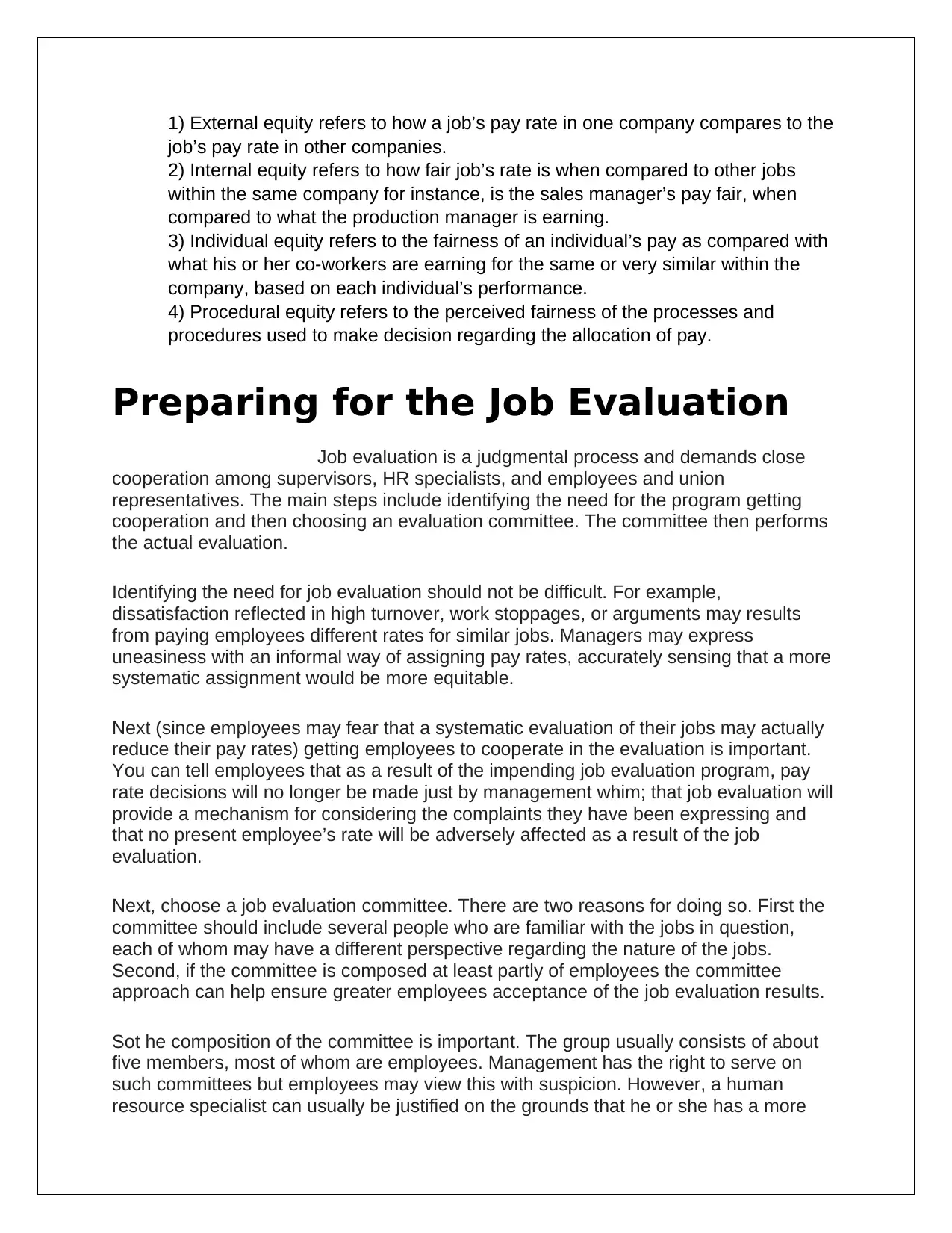
1) External equity refers to how a job’s pay rate in one company compares to the
job’s pay rate in other companies.
2) Internal equity refers to how fair job’s rate is when compared to other jobs
within the same company for instance, is the sales manager’s pay fair, when
compared to what the production manager is earning.
3) Individual equity refers to the fairness of an individual’s pay as compared with
what his or her co-workers are earning for the same or very similar within the
company, based on each individual’s performance.
4) Procedural equity refers to the perceived fairness of the processes and
procedures used to make decision regarding the allocation of pay.
Preparing for the Job Evaluation
Job evaluation is a judgmental process and demands close
cooperation among supervisors, HR specialists, and employees and union
representatives. The main steps include identifying the need for the program getting
cooperation and then choosing an evaluation committee. The committee then performs
the actual evaluation.
Identifying the need for job evaluation should not be difficult. For example,
dissatisfaction reflected in high turnover, work stoppages, or arguments may results
from paying employees different rates for similar jobs. Managers may express
uneasiness with an informal way of assigning pay rates, accurately sensing that a more
systematic assignment would be more equitable.
Next (since employees may fear that a systematic evaluation of their jobs may actually
reduce their pay rates) getting employees to cooperate in the evaluation is important.
You can tell employees that as a result of the impending job evaluation program, pay
rate decisions will no longer be made just by management whim; that job evaluation will
provide a mechanism for considering the complaints they have been expressing and
that no present employee’s rate will be adversely affected as a result of the job
evaluation.
Next, choose a job evaluation committee. There are two reasons for doing so. First the
committee should include several people who are familiar with the jobs in question,
each of whom may have a different perspective regarding the nature of the jobs.
Second, if the committee is composed at least partly of employees the committee
approach can help ensure greater employees acceptance of the job evaluation results.
Sot he composition of the committee is important. The group usually consists of about
five members, most of whom are employees. Management has the right to serve on
such committees but employees may view this with suspicion. However, a human
resource specialist can usually be justified on the grounds that he or she has a more
job’s pay rate in other companies.
2) Internal equity refers to how fair job’s rate is when compared to other jobs
within the same company for instance, is the sales manager’s pay fair, when
compared to what the production manager is earning.
3) Individual equity refers to the fairness of an individual’s pay as compared with
what his or her co-workers are earning for the same or very similar within the
company, based on each individual’s performance.
4) Procedural equity refers to the perceived fairness of the processes and
procedures used to make decision regarding the allocation of pay.
Preparing for the Job Evaluation
Job evaluation is a judgmental process and demands close
cooperation among supervisors, HR specialists, and employees and union
representatives. The main steps include identifying the need for the program getting
cooperation and then choosing an evaluation committee. The committee then performs
the actual evaluation.
Identifying the need for job evaluation should not be difficult. For example,
dissatisfaction reflected in high turnover, work stoppages, or arguments may results
from paying employees different rates for similar jobs. Managers may express
uneasiness with an informal way of assigning pay rates, accurately sensing that a more
systematic assignment would be more equitable.
Next (since employees may fear that a systematic evaluation of their jobs may actually
reduce their pay rates) getting employees to cooperate in the evaluation is important.
You can tell employees that as a result of the impending job evaluation program, pay
rate decisions will no longer be made just by management whim; that job evaluation will
provide a mechanism for considering the complaints they have been expressing and
that no present employee’s rate will be adversely affected as a result of the job
evaluation.
Next, choose a job evaluation committee. There are two reasons for doing so. First the
committee should include several people who are familiar with the jobs in question,
each of whom may have a different perspective regarding the nature of the jobs.
Second, if the committee is composed at least partly of employees the committee
approach can help ensure greater employees acceptance of the job evaluation results.
Sot he composition of the committee is important. The group usually consists of about
five members, most of whom are employees. Management has the right to serve on
such committees but employees may view this with suspicion. However, a human
resource specialist can usually be justified on the grounds that he or she has a more
Paraphrase This Document
Need a fresh take? Get an instant paraphrase of this document with our AI Paraphraser
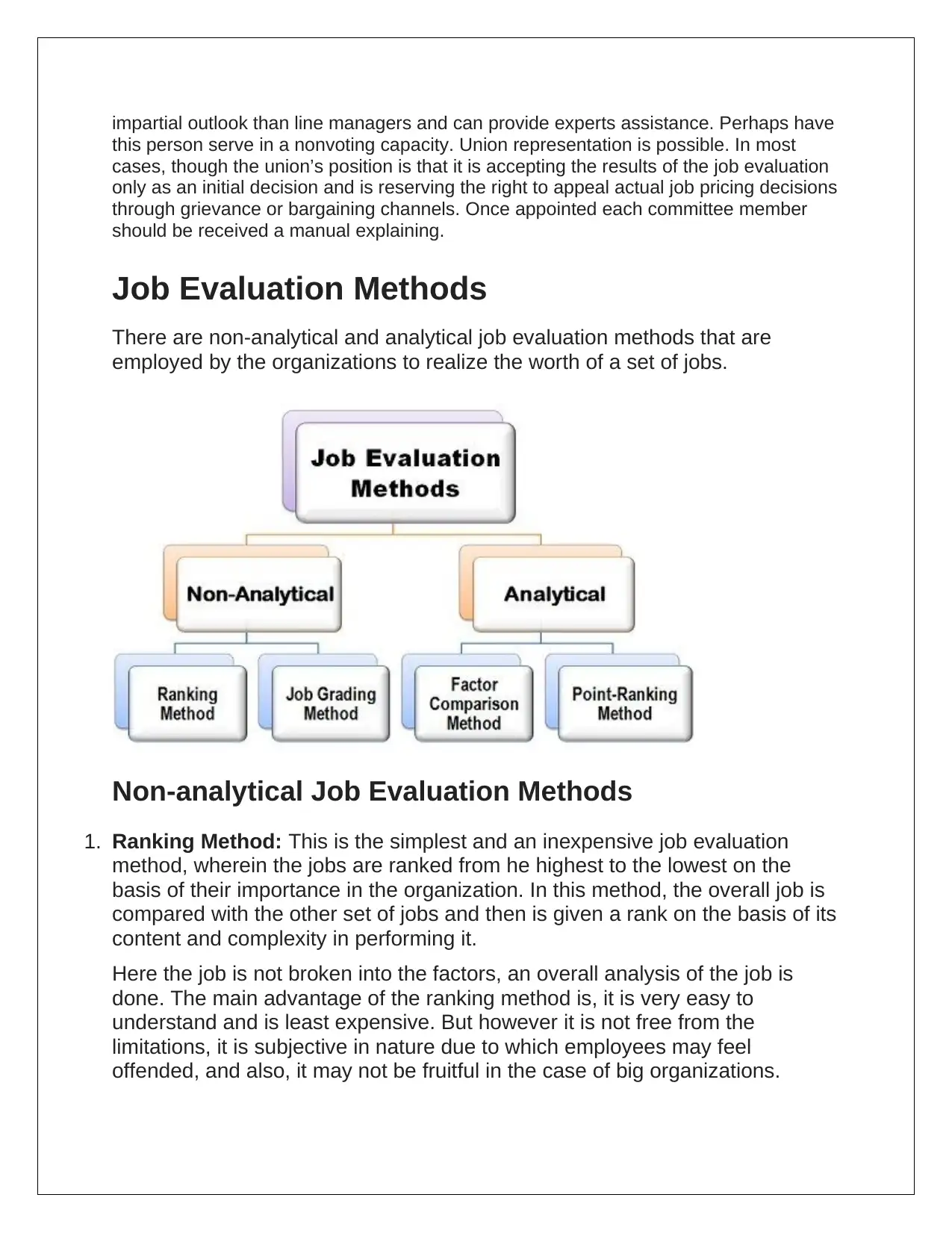
impartial outlook than line managers and can provide experts assistance. Perhaps have
this person serve in a nonvoting capacity. Union representation is possible. In most
cases, though the union’s position is that it is accepting the results of the job evaluation
only as an initial decision and is reserving the right to appeal actual job pricing decisions
through grievance or bargaining channels. Once appointed each committee member
should be received a manual explaining.
Job Evaluation Methods
There are non-analytical and analytical job evaluation methods that are
employed by the organizations to realize the worth of a set of jobs.
Non-analytical Job Evaluation Methods
1. Ranking Method: This is the simplest and an inexpensive job evaluation
method, wherein the jobs are ranked from he highest to the lowest on the
basis of their importance in the organization. In this method, the overall job is
compared with the other set of jobs and then is given a rank on the basis of its
content and complexity in performing it.
Here the job is not broken into the factors, an overall analysis of the job is
done. The main advantage of the ranking method is, it is very easy to
understand and is least expensive. But however it is not free from the
limitations, it is subjective in nature due to which employees may feel
offended, and also, it may not be fruitful in the case of big organizations.
this person serve in a nonvoting capacity. Union representation is possible. In most
cases, though the union’s position is that it is accepting the results of the job evaluation
only as an initial decision and is reserving the right to appeal actual job pricing decisions
through grievance or bargaining channels. Once appointed each committee member
should be received a manual explaining.
Job Evaluation Methods
There are non-analytical and analytical job evaluation methods that are
employed by the organizations to realize the worth of a set of jobs.
Non-analytical Job Evaluation Methods
1. Ranking Method: This is the simplest and an inexpensive job evaluation
method, wherein the jobs are ranked from he highest to the lowest on the
basis of their importance in the organization. In this method, the overall job is
compared with the other set of jobs and then is given a rank on the basis of its
content and complexity in performing it.
Here the job is not broken into the factors, an overall analysis of the job is
done. The main advantage of the ranking method is, it is very easy to
understand and is least expensive. But however it is not free from the
limitations, it is subjective in nature due to which employees may feel
offended, and also, it may not be fruitful in the case of big organizations.
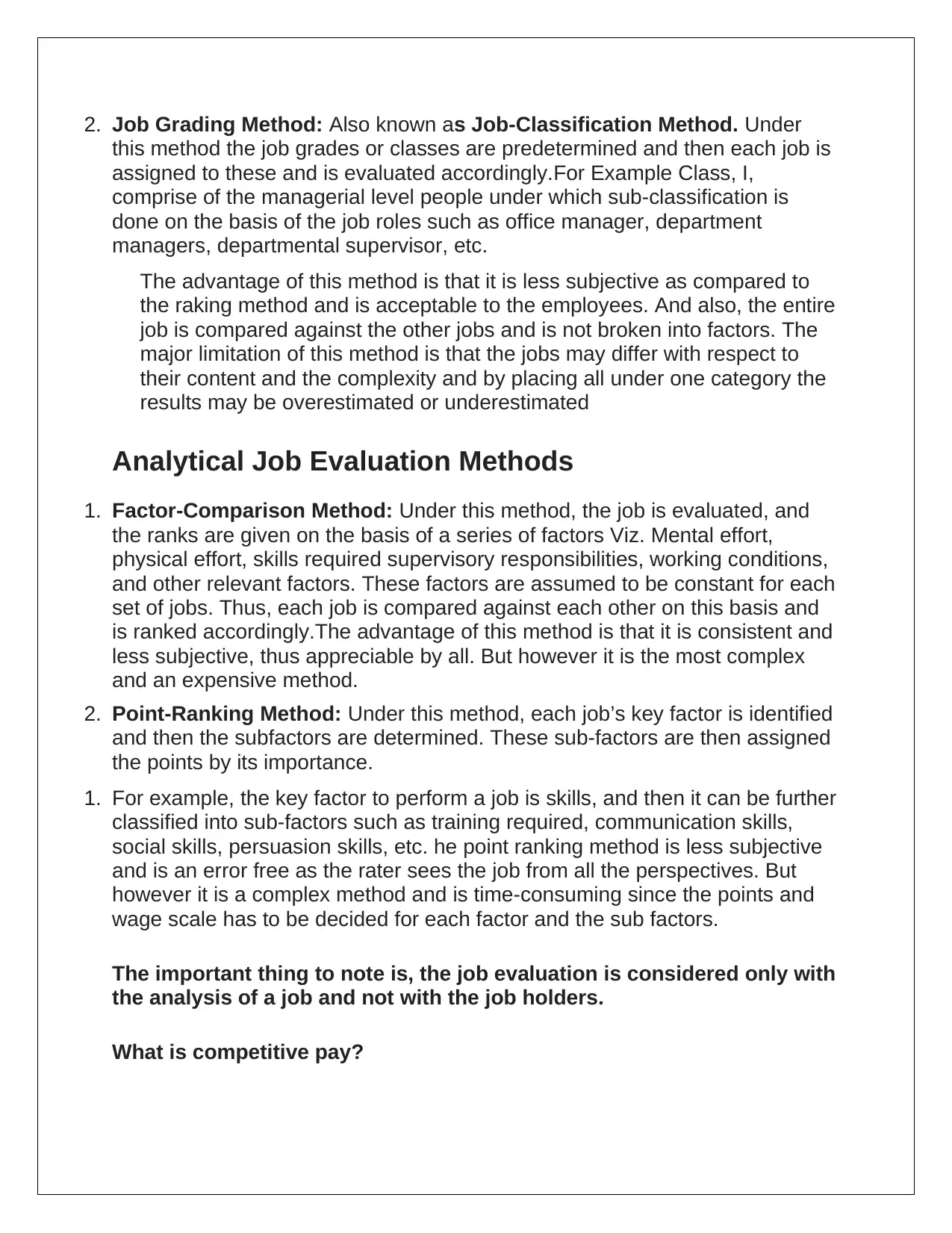
2. Job Grading Method: Also known as Job-Classification Method. Under
this method the job grades or classes are predetermined and then each job is
assigned to these and is evaluated accordingly.For Example Class, I,
comprise of the managerial level people under which sub-classification is
done on the basis of the job roles such as office manager, department
managers, departmental supervisor, etc.
The advantage of this method is that it is less subjective as compared to
the raking method and is acceptable to the employees. And also, the entire
job is compared against the other jobs and is not broken into factors. The
major limitation of this method is that the jobs may differ with respect to
their content and the complexity and by placing all under one category the
results may be overestimated or underestimated
Analytical Job Evaluation Methods
1. Factor-Comparison Method: Under this method, the job is evaluated, and
the ranks are given on the basis of a series of factors Viz. Mental effort,
physical effort, skills required supervisory responsibilities, working conditions,
and other relevant factors. These factors are assumed to be constant for each
set of jobs. Thus, each job is compared against each other on this basis and
is ranked accordingly.The advantage of this method is that it is consistent and
less subjective, thus appreciable by all. But however it is the most complex
and an expensive method.
2. Point-Ranking Method: Under this method, each job’s key factor is identified
and then the subfactors are determined. These sub-factors are then assigned
the points by its importance.
1. For example, the key factor to perform a job is skills, and then it can be further
classified into sub-factors such as training required, communication skills,
social skills, persuasion skills, etc. he point ranking method is less subjective
and is an error free as the rater sees the job from all the perspectives. But
however it is a complex method and is time-consuming since the points and
wage scale has to be decided for each factor and the sub factors.
The important thing to note is, the job evaluation is considered only with
the analysis of a job and not with the job holders.
What is competitive pay?
this method the job grades or classes are predetermined and then each job is
assigned to these and is evaluated accordingly.For Example Class, I,
comprise of the managerial level people under which sub-classification is
done on the basis of the job roles such as office manager, department
managers, departmental supervisor, etc.
The advantage of this method is that it is less subjective as compared to
the raking method and is acceptable to the employees. And also, the entire
job is compared against the other jobs and is not broken into factors. The
major limitation of this method is that the jobs may differ with respect to
their content and the complexity and by placing all under one category the
results may be overestimated or underestimated
Analytical Job Evaluation Methods
1. Factor-Comparison Method: Under this method, the job is evaluated, and
the ranks are given on the basis of a series of factors Viz. Mental effort,
physical effort, skills required supervisory responsibilities, working conditions,
and other relevant factors. These factors are assumed to be constant for each
set of jobs. Thus, each job is compared against each other on this basis and
is ranked accordingly.The advantage of this method is that it is consistent and
less subjective, thus appreciable by all. But however it is the most complex
and an expensive method.
2. Point-Ranking Method: Under this method, each job’s key factor is identified
and then the subfactors are determined. These sub-factors are then assigned
the points by its importance.
1. For example, the key factor to perform a job is skills, and then it can be further
classified into sub-factors such as training required, communication skills,
social skills, persuasion skills, etc. he point ranking method is less subjective
and is an error free as the rater sees the job from all the perspectives. But
however it is a complex method and is time-consuming since the points and
wage scale has to be decided for each factor and the sub factors.
The important thing to note is, the job evaluation is considered only with
the analysis of a job and not with the job holders.
What is competitive pay?
⊘ This is a preview!⊘
Do you want full access?
Subscribe today to unlock all pages.

Trusted by 1+ million students worldwide
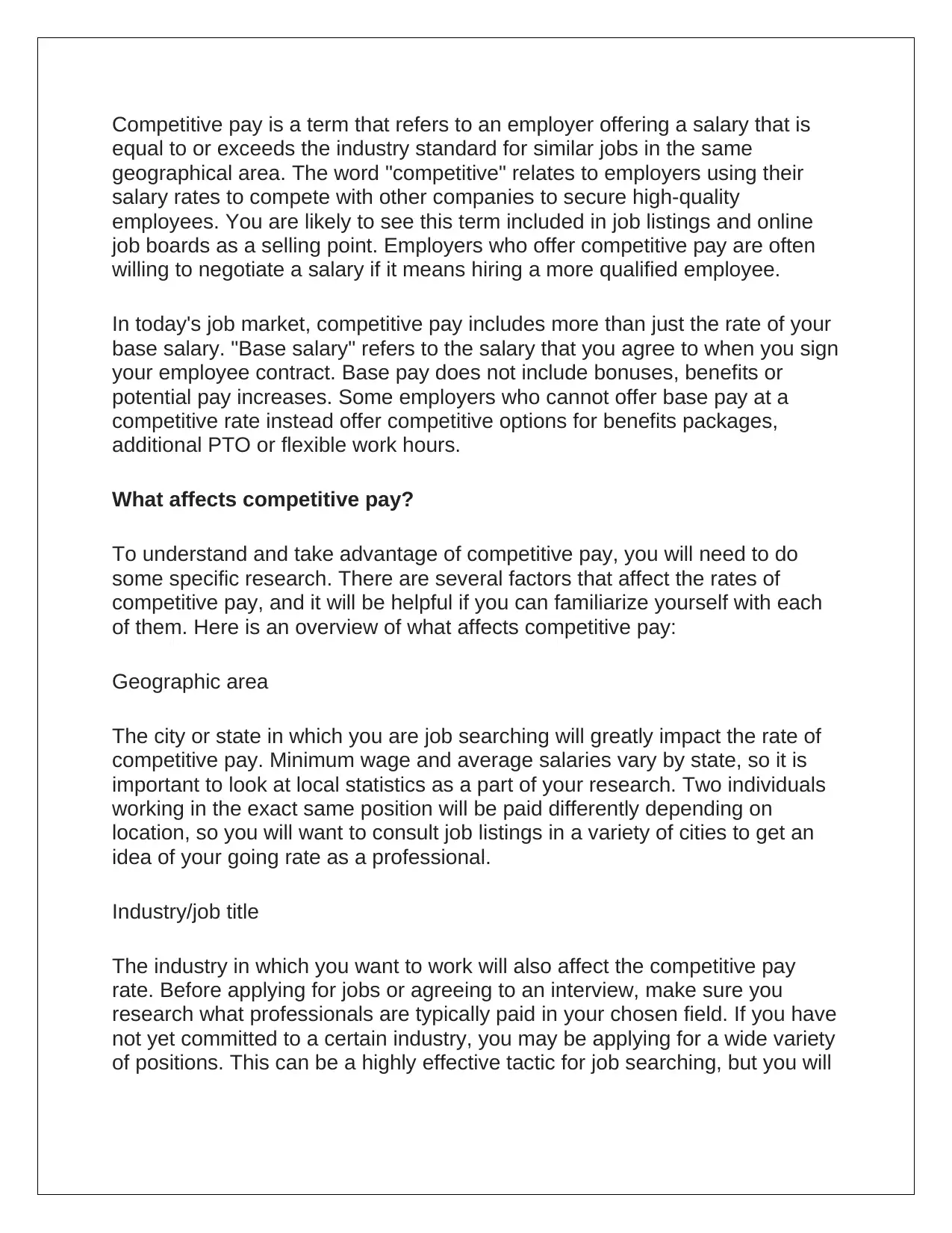
Competitive pay is a term that refers to an employer offering a salary that is
equal to or exceeds the industry standard for similar jobs in the same
geographical area. The word "competitive" relates to employers using their
salary rates to compete with other companies to secure high-quality
employees. You are likely to see this term included in job listings and online
job boards as a selling point. Employers who offer competitive pay are often
willing to negotiate a salary if it means hiring a more qualified employee.
In today's job market, competitive pay includes more than just the rate of your
base salary. "Base salary" refers to the salary that you agree to when you sign
your employee contract. Base pay does not include bonuses, benefits or
potential pay increases. Some employers who cannot offer base pay at a
competitive rate instead offer competitive options for benefits packages,
additional PTO or flexible work hours.
What affects competitive pay?
To understand and take advantage of competitive pay, you will need to do
some specific research. There are several factors that affect the rates of
competitive pay, and it will be helpful if you can familiarize yourself with each
of them. Here is an overview of what affects competitive pay:
Geographic area
The city or state in which you are job searching will greatly impact the rate of
competitive pay. Minimum wage and average salaries vary by state, so it is
important to look at local statistics as a part of your research. Two individuals
working in the exact same position will be paid differently depending on
location, so you will want to consult job listings in a variety of cities to get an
idea of your going rate as a professional.
Industry/job title
The industry in which you want to work will also affect the competitive pay
rate. Before applying for jobs or agreeing to an interview, make sure you
research what professionals are typically paid in your chosen field. If you have
not yet committed to a certain industry, you may be applying for a wide variety
of positions. This can be a highly effective tactic for job searching, but you will
equal to or exceeds the industry standard for similar jobs in the same
geographical area. The word "competitive" relates to employers using their
salary rates to compete with other companies to secure high-quality
employees. You are likely to see this term included in job listings and online
job boards as a selling point. Employers who offer competitive pay are often
willing to negotiate a salary if it means hiring a more qualified employee.
In today's job market, competitive pay includes more than just the rate of your
base salary. "Base salary" refers to the salary that you agree to when you sign
your employee contract. Base pay does not include bonuses, benefits or
potential pay increases. Some employers who cannot offer base pay at a
competitive rate instead offer competitive options for benefits packages,
additional PTO or flexible work hours.
What affects competitive pay?
To understand and take advantage of competitive pay, you will need to do
some specific research. There are several factors that affect the rates of
competitive pay, and it will be helpful if you can familiarize yourself with each
of them. Here is an overview of what affects competitive pay:
Geographic area
The city or state in which you are job searching will greatly impact the rate of
competitive pay. Minimum wage and average salaries vary by state, so it is
important to look at local statistics as a part of your research. Two individuals
working in the exact same position will be paid differently depending on
location, so you will want to consult job listings in a variety of cities to get an
idea of your going rate as a professional.
Industry/job title
The industry in which you want to work will also affect the competitive pay
rate. Before applying for jobs or agreeing to an interview, make sure you
research what professionals are typically paid in your chosen field. If you have
not yet committed to a certain industry, you may be applying for a wide variety
of positions. This can be a highly effective tactic for job searching, but you will
Paraphrase This Document
Need a fresh take? Get an instant paraphrase of this document with our AI Paraphraser
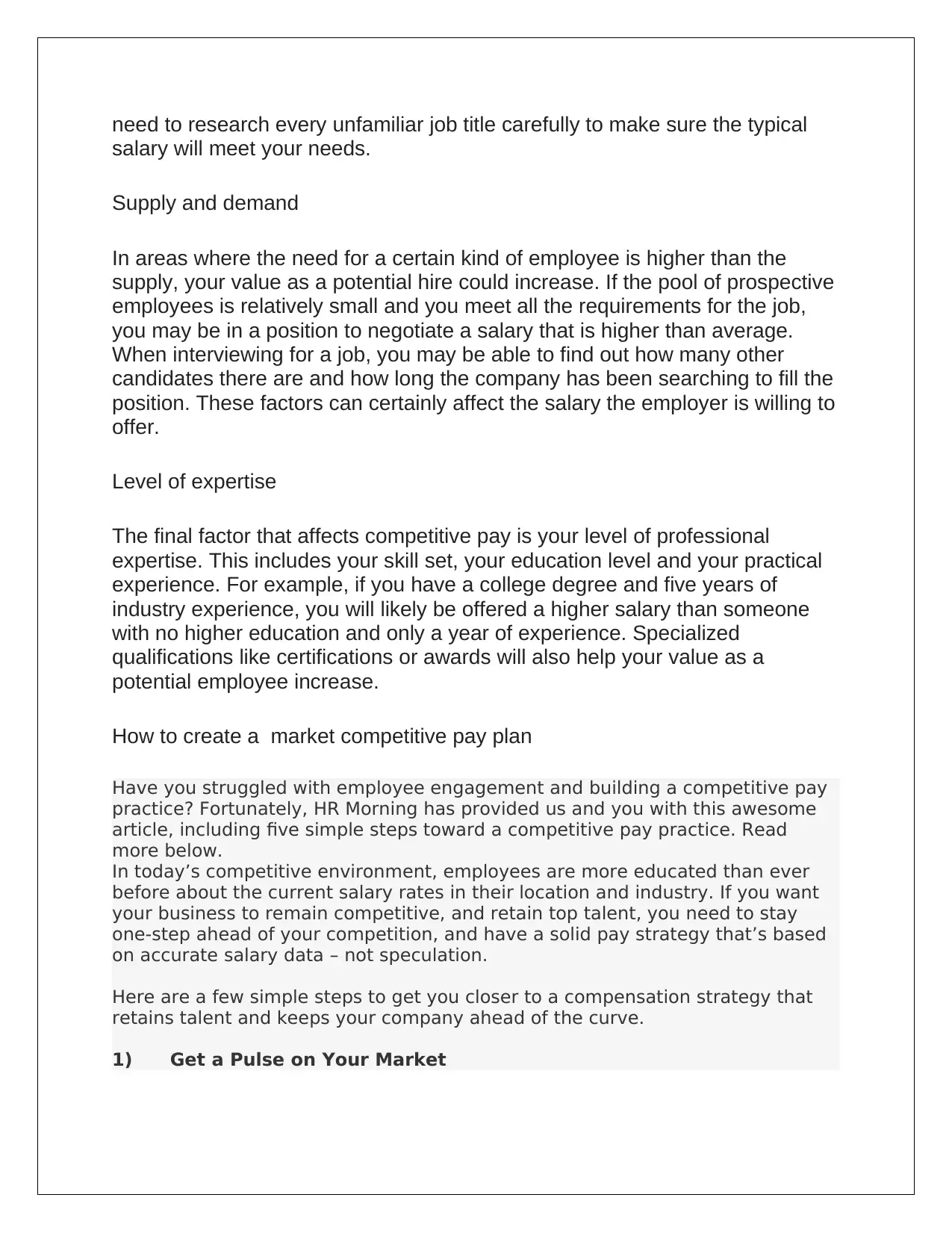
need to research every unfamiliar job title carefully to make sure the typical
salary will meet your needs.
Supply and demand
In areas where the need for a certain kind of employee is higher than the
supply, your value as a potential hire could increase. If the pool of prospective
employees is relatively small and you meet all the requirements for the job,
you may be in a position to negotiate a salary that is higher than average.
When interviewing for a job, you may be able to find out how many other
candidates there are and how long the company has been searching to fill the
position. These factors can certainly affect the salary the employer is willing to
offer.
Level of expertise
The final factor that affects competitive pay is your level of professional
expertise. This includes your skill set, your education level and your practical
experience. For example, if you have a college degree and five years of
industry experience, you will likely be offered a higher salary than someone
with no higher education and only a year of experience. Specialized
qualifications like certifications or awards will also help your value as a
potential employee increase.
How to create a market competitive pay plan
Have you struggled with employee engagement and building a competitive pay
practice? Fortunately, HR Morning has provided us and you with this awesome
article, including five simple steps toward a competitive pay practice. Read
more below.
In today’s competitive environment, employees are more educated than ever
before about the current salary rates in their location and industry. If you want
your business to remain competitive, and retain top talent, you need to stay
one-step ahead of your competition, and have a solid pay strategy that’s based
on accurate salary data – not speculation.
Here are a few simple steps to get you closer to a compensation strategy that
retains talent and keeps your company ahead of the curve.
1) Get a Pulse on Your Market
salary will meet your needs.
Supply and demand
In areas where the need for a certain kind of employee is higher than the
supply, your value as a potential hire could increase. If the pool of prospective
employees is relatively small and you meet all the requirements for the job,
you may be in a position to negotiate a salary that is higher than average.
When interviewing for a job, you may be able to find out how many other
candidates there are and how long the company has been searching to fill the
position. These factors can certainly affect the salary the employer is willing to
offer.
Level of expertise
The final factor that affects competitive pay is your level of professional
expertise. This includes your skill set, your education level and your practical
experience. For example, if you have a college degree and five years of
industry experience, you will likely be offered a higher salary than someone
with no higher education and only a year of experience. Specialized
qualifications like certifications or awards will also help your value as a
potential employee increase.
How to create a market competitive pay plan
Have you struggled with employee engagement and building a competitive pay
practice? Fortunately, HR Morning has provided us and you with this awesome
article, including five simple steps toward a competitive pay practice. Read
more below.
In today’s competitive environment, employees are more educated than ever
before about the current salary rates in their location and industry. If you want
your business to remain competitive, and retain top talent, you need to stay
one-step ahead of your competition, and have a solid pay strategy that’s based
on accurate salary data – not speculation.
Here are a few simple steps to get you closer to a compensation strategy that
retains talent and keeps your company ahead of the curve.
1) Get a Pulse on Your Market
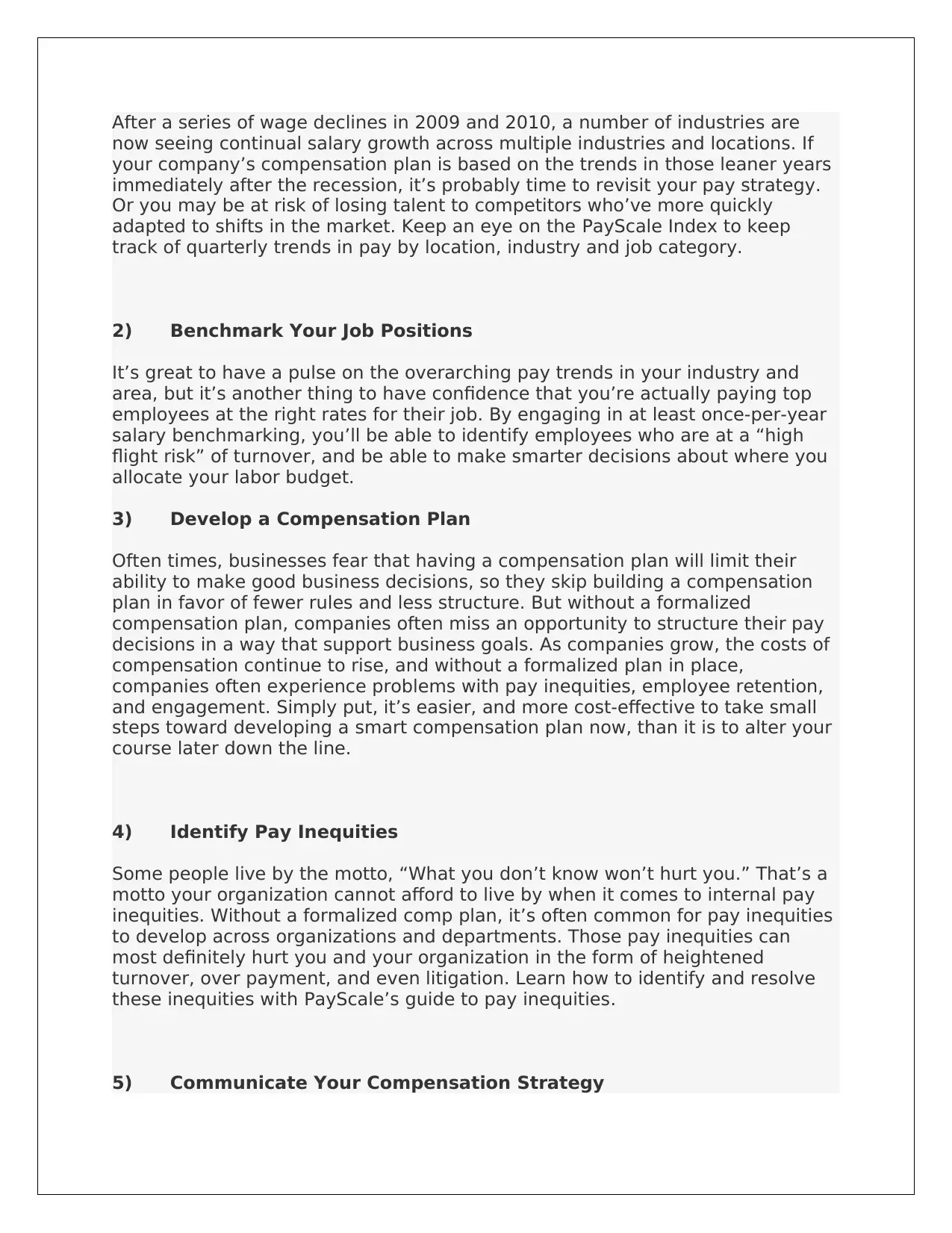
After a series of wage declines in 2009 and 2010, a number of industries are
now seeing continual salary growth across multiple industries and locations. If
your company’s compensation plan is based on the trends in those leaner years
immediately after the recession, it’s probably time to revisit your pay strategy.
Or you may be at risk of losing talent to competitors who’ve more quickly
adapted to shifts in the market. Keep an eye on the PayScale Index to keep
track of quarterly trends in pay by location, industry and job category.
2) Benchmark Your Job Positions
It’s great to have a pulse on the overarching pay trends in your industry and
area, but it’s another thing to have confidence that you’re actually paying top
employees at the right rates for their job. By engaging in at least once-per-year
salary benchmarking, you’ll be able to identify employees who are at a “high
flight risk” of turnover, and be able to make smarter decisions about where you
allocate your labor budget.
3) Develop a Compensation Plan
Often times, businesses fear that having a compensation plan will limit their
ability to make good business decisions, so they skip building a compensation
plan in favor of fewer rules and less structure. But without a formalized
compensation plan, companies often miss an opportunity to structure their pay
decisions in a way that support business goals. As companies grow, the costs of
compensation continue to rise, and without a formalized plan in place,
companies often experience problems with pay inequities, employee retention,
and engagement. Simply put, it’s easier, and more cost-effective to take small
steps toward developing a smart compensation plan now, than it is to alter your
course later down the line.
4) Identify Pay Inequities
Some people live by the motto, “What you don’t know won’t hurt you.” That’s a
motto your organization cannot afford to live by when it comes to internal pay
inequities. Without a formalized comp plan, it’s often common for pay inequities
to develop across organizations and departments. Those pay inequities can
most definitely hurt you and your organization in the form of heightened
turnover, over payment, and even litigation. Learn how to identify and resolve
these inequities with PayScale’s guide to pay inequities.
5) Communicate Your Compensation Strategy
now seeing continual salary growth across multiple industries and locations. If
your company’s compensation plan is based on the trends in those leaner years
immediately after the recession, it’s probably time to revisit your pay strategy.
Or you may be at risk of losing talent to competitors who’ve more quickly
adapted to shifts in the market. Keep an eye on the PayScale Index to keep
track of quarterly trends in pay by location, industry and job category.
2) Benchmark Your Job Positions
It’s great to have a pulse on the overarching pay trends in your industry and
area, but it’s another thing to have confidence that you’re actually paying top
employees at the right rates for their job. By engaging in at least once-per-year
salary benchmarking, you’ll be able to identify employees who are at a “high
flight risk” of turnover, and be able to make smarter decisions about where you
allocate your labor budget.
3) Develop a Compensation Plan
Often times, businesses fear that having a compensation plan will limit their
ability to make good business decisions, so they skip building a compensation
plan in favor of fewer rules and less structure. But without a formalized
compensation plan, companies often miss an opportunity to structure their pay
decisions in a way that support business goals. As companies grow, the costs of
compensation continue to rise, and without a formalized plan in place,
companies often experience problems with pay inequities, employee retention,
and engagement. Simply put, it’s easier, and more cost-effective to take small
steps toward developing a smart compensation plan now, than it is to alter your
course later down the line.
4) Identify Pay Inequities
Some people live by the motto, “What you don’t know won’t hurt you.” That’s a
motto your organization cannot afford to live by when it comes to internal pay
inequities. Without a formalized comp plan, it’s often common for pay inequities
to develop across organizations and departments. Those pay inequities can
most definitely hurt you and your organization in the form of heightened
turnover, over payment, and even litigation. Learn how to identify and resolve
these inequities with PayScale’s guide to pay inequities.
5) Communicate Your Compensation Strategy
⊘ This is a preview!⊘
Do you want full access?
Subscribe today to unlock all pages.

Trusted by 1+ million students worldwide
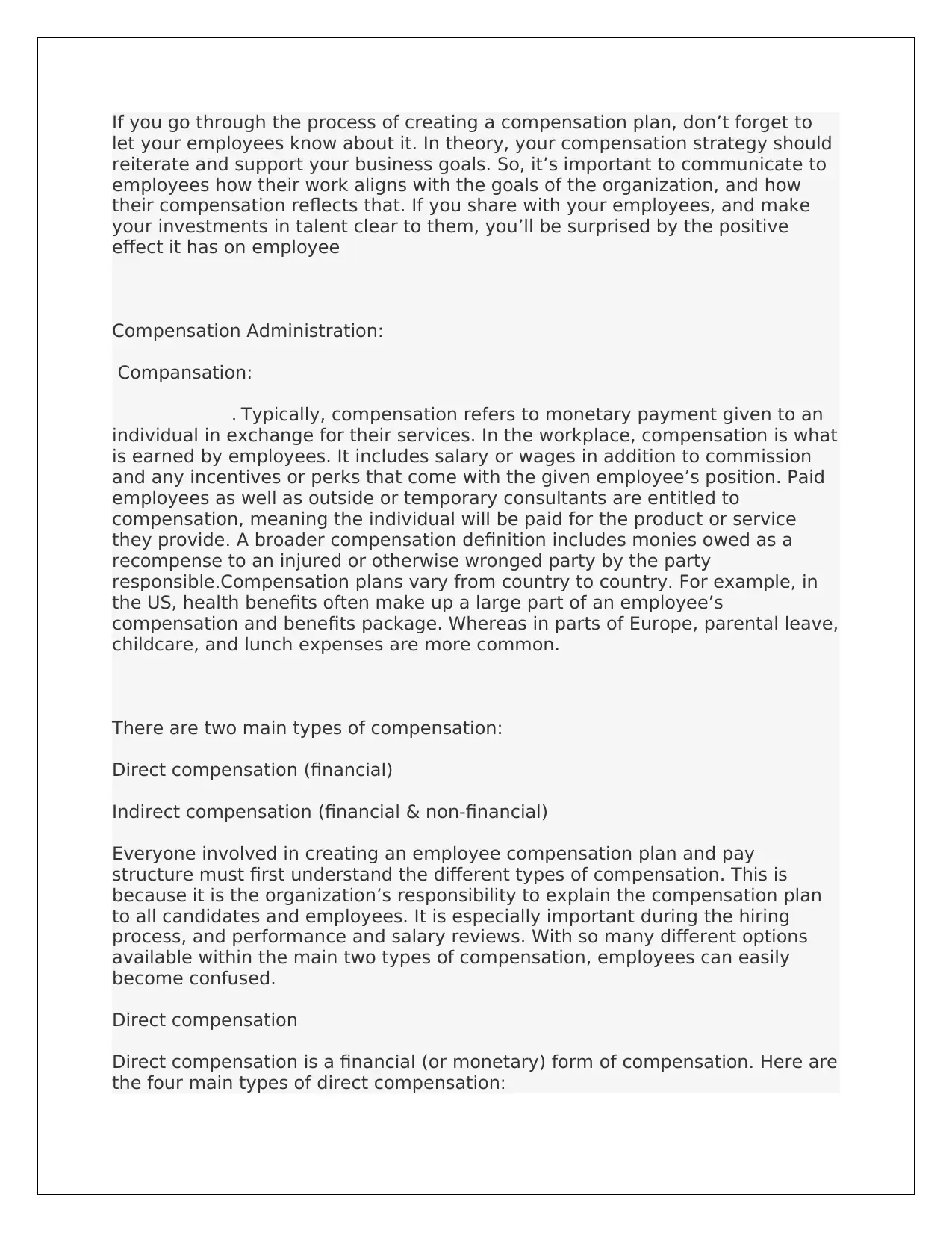
If you go through the process of creating a compensation plan, don’t forget to
let your employees know about it. In theory, your compensation strategy should
reiterate and support your business goals. So, it’s important to communicate to
employees how their work aligns with the goals of the organization, and how
their compensation reflects that. If you share with your employees, and make
your investments in talent clear to them, you’ll be surprised by the positive
effect it has on employee
Compensation Administration:
Compansation:
. Typically, compensation refers to monetary payment given to an
individual in exchange for their services. In the workplace, compensation is what
is earned by employees. It includes salary or wages in addition to commission
and any incentives or perks that come with the given employee’s position. Paid
employees as well as outside or temporary consultants are entitled to
compensation, meaning the individual will be paid for the product or service
they provide. A broader compensation definition includes monies owed as a
recompense to an injured or otherwise wronged party by the party
responsible.Compensation plans vary from country to country. For example, in
the US, health benefits often make up a large part of an employee’s
compensation and benefits package. Whereas in parts of Europe, parental leave,
childcare, and lunch expenses are more common.
There are two main types of compensation:
Direct compensation (financial)
Indirect compensation (financial & non-financial)
Everyone involved in creating an employee compensation plan and pay
structure must first understand the different types of compensation. This is
because it is the organization’s responsibility to explain the compensation plan
to all candidates and employees. It is especially important during the hiring
process, and performance and salary reviews. With so many different options
available within the main two types of compensation, employees can easily
become confused.
Direct compensation
Direct compensation is a financial (or monetary) form of compensation. Here are
the four main types of direct compensation:
let your employees know about it. In theory, your compensation strategy should
reiterate and support your business goals. So, it’s important to communicate to
employees how their work aligns with the goals of the organization, and how
their compensation reflects that. If you share with your employees, and make
your investments in talent clear to them, you’ll be surprised by the positive
effect it has on employee
Compensation Administration:
Compansation:
. Typically, compensation refers to monetary payment given to an
individual in exchange for their services. In the workplace, compensation is what
is earned by employees. It includes salary or wages in addition to commission
and any incentives or perks that come with the given employee’s position. Paid
employees as well as outside or temporary consultants are entitled to
compensation, meaning the individual will be paid for the product or service
they provide. A broader compensation definition includes monies owed as a
recompense to an injured or otherwise wronged party by the party
responsible.Compensation plans vary from country to country. For example, in
the US, health benefits often make up a large part of an employee’s
compensation and benefits package. Whereas in parts of Europe, parental leave,
childcare, and lunch expenses are more common.
There are two main types of compensation:
Direct compensation (financial)
Indirect compensation (financial & non-financial)
Everyone involved in creating an employee compensation plan and pay
structure must first understand the different types of compensation. This is
because it is the organization’s responsibility to explain the compensation plan
to all candidates and employees. It is especially important during the hiring
process, and performance and salary reviews. With so many different options
available within the main two types of compensation, employees can easily
become confused.
Direct compensation
Direct compensation is a financial (or monetary) form of compensation. Here are
the four main types of direct compensation:
Paraphrase This Document
Need a fresh take? Get an instant paraphrase of this document with our AI Paraphraser
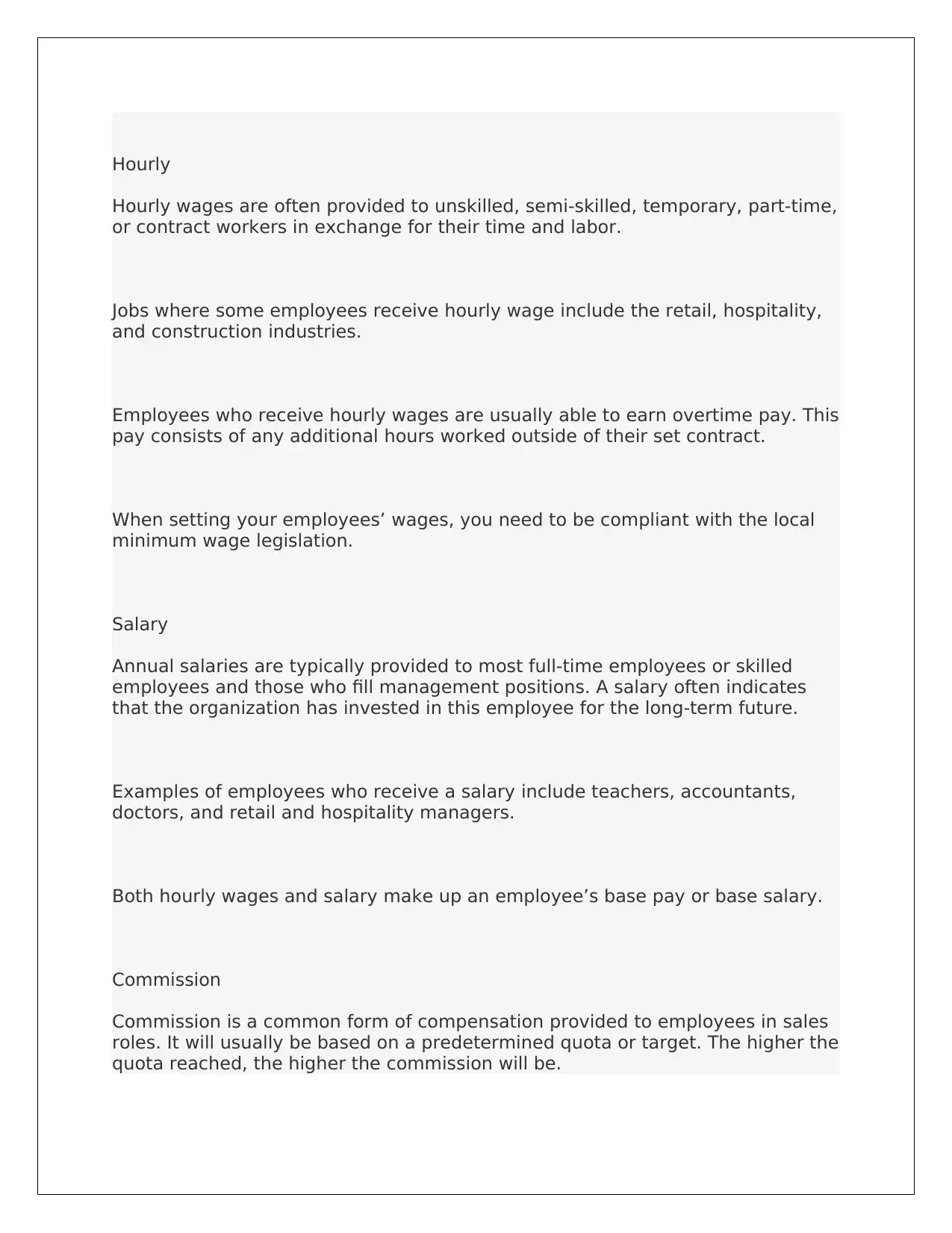
Hourly
Hourly wages are often provided to unskilled, semi-skilled, temporary, part-time,
or contract workers in exchange for their time and labor.
Jobs where some employees receive hourly wage include the retail, hospitality,
and construction industries.
Employees who receive hourly wages are usually able to earn overtime pay. This
pay consists of any additional hours worked outside of their set contract.
When setting your employees’ wages, you need to be compliant with the local
minimum wage legislation.
Salary
Annual salaries are typically provided to most full-time employees or skilled
employees and those who fill management positions. A salary often indicates
that the organization has invested in this employee for the long-term future.
Examples of employees who receive a salary include teachers, accountants,
doctors, and retail and hospitality managers.
Both hourly wages and salary make up an employee’s base pay or base salary.
Commission
Commission is a common form of compensation provided to employees in sales
roles. It will usually be based on a predetermined quota or target. The higher the
quota reached, the higher the commission will be.
Hourly wages are often provided to unskilled, semi-skilled, temporary, part-time,
or contract workers in exchange for their time and labor.
Jobs where some employees receive hourly wage include the retail, hospitality,
and construction industries.
Employees who receive hourly wages are usually able to earn overtime pay. This
pay consists of any additional hours worked outside of their set contract.
When setting your employees’ wages, you need to be compliant with the local
minimum wage legislation.
Salary
Annual salaries are typically provided to most full-time employees or skilled
employees and those who fill management positions. A salary often indicates
that the organization has invested in this employee for the long-term future.
Examples of employees who receive a salary include teachers, accountants,
doctors, and retail and hospitality managers.
Both hourly wages and salary make up an employee’s base pay or base salary.
Commission
Commission is a common form of compensation provided to employees in sales
roles. It will usually be based on a predetermined quota or target. The higher the
quota reached, the higher the commission will be.
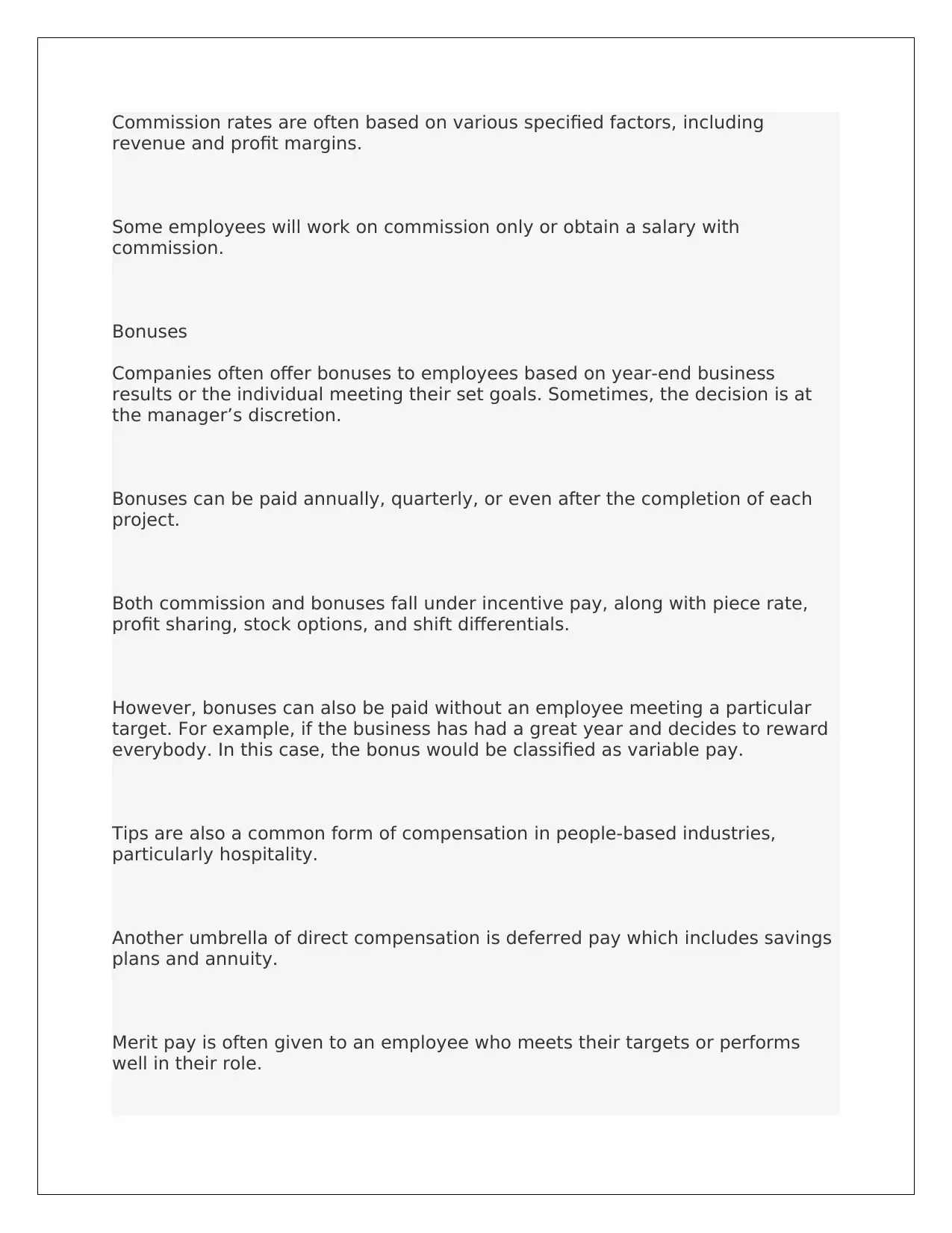
Commission rates are often based on various specified factors, including
revenue and profit margins.
Some employees will work on commission only or obtain a salary with
commission.
Bonuses
Companies often offer bonuses to employees based on year-end business
results or the individual meeting their set goals. Sometimes, the decision is at
the manager’s discretion.
Bonuses can be paid annually, quarterly, or even after the completion of each
project.
Both commission and bonuses fall under incentive pay, along with piece rate,
profit sharing, stock options, and shift differentials.
However, bonuses can also be paid without an employee meeting a particular
target. For example, if the business has had a great year and decides to reward
everybody. In this case, the bonus would be classified as variable pay.
Tips are also a common form of compensation in people-based industries,
particularly hospitality.
Another umbrella of direct compensation is deferred pay which includes savings
plans and annuity.
Merit pay is often given to an employee who meets their targets or performs
well in their role.
revenue and profit margins.
Some employees will work on commission only or obtain a salary with
commission.
Bonuses
Companies often offer bonuses to employees based on year-end business
results or the individual meeting their set goals. Sometimes, the decision is at
the manager’s discretion.
Bonuses can be paid annually, quarterly, or even after the completion of each
project.
Both commission and bonuses fall under incentive pay, along with piece rate,
profit sharing, stock options, and shift differentials.
However, bonuses can also be paid without an employee meeting a particular
target. For example, if the business has had a great year and decides to reward
everybody. In this case, the bonus would be classified as variable pay.
Tips are also a common form of compensation in people-based industries,
particularly hospitality.
Another umbrella of direct compensation is deferred pay which includes savings
plans and annuity.
Merit pay is often given to an employee who meets their targets or performs
well in their role.
⊘ This is a preview!⊘
Do you want full access?
Subscribe today to unlock all pages.

Trusted by 1+ million students worldwide
1 out of 13
Related Documents
Your All-in-One AI-Powered Toolkit for Academic Success.
+13062052269
info@desklib.com
Available 24*7 on WhatsApp / Email
![[object Object]](/_next/static/media/star-bottom.7253800d.svg)
Unlock your academic potential
Copyright © 2020–2025 A2Z Services. All Rights Reserved. Developed and managed by ZUCOL.





